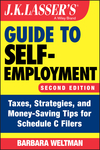Estimated Taxes for Self-Employed Individuals
Employees have their tax obligations met largely by income tax withholding from each paycheck. If you are working as a self-employed individual so that you’re not on the payroll as an employee, you don’t get a paycheck from which taxes can be withheld. You’ll need to set aside taxes and pay them to the government on a quarterly basis.
What Are Quarterly Payments?
You can’t wait until tax time to pay your full tax bill because the federal tax system operates on a pay-as-you-go basis. If you fail to comply with estimated tax rules, you’ll owe penalties.
Estimated taxes are paid four times a year, but they aren’t evenly spaced. Payment dates for 2010, for example, are April 15, 2010, June 15, 2010, September 15, 2010, and January 15, 2011.
You must pay estimated taxes according to projections of your tax liability for the year. No payments are required if your total federal income tax bill, including self-employment tax, is less than $1,000.
How to Figure Estimated Tax Payments
You’ll want each installment to be one-fourth of what you expect to owe for the year. Again, your tax bill includes not only income tax on your business profits and other income, but also self-employment tax to cover your Social Security and Medicare taxes.
Again, if you fail to pay enough estimated taxes, you may be subject to a penalty based on prevailing interest rates. You can escape penalty by relying on an IRS safe harbor that lets you fix installments by paying:
- 90% of your current tax bill. If you fall short by 10% or less, there won’t be any penalty, or
- 100% of last year’s tax bill (or 110% if your adjusted gross income last year was at least $150,000, or $75,000 if married filing separately).
Note: A special safe harbor for small business owners applied only to 2009 estimated taxes; it does not apply for 2010.
Putting Money Aside
In order to meet estimated tax requirements, you’ll need to set a portion of your revenue aside so you’ll have cash on hand to pay your taxes. This means that of every $1,000 of revenue you take in, you’ll need to put a portion of it aside so you can meet estimated tax requirements.
Unfortunately, an estimated 60% of all self-employed individuals fail to meet estimated tax requirements. The result: They owe penalties and can get into deeper tax trouble by not filing returns or by having to file separately from a spouse (resulting in higher tax payments).
You can avoid penalties and other problems related to estimated tax obligations by disciplining yourself to allot revenues to a separate account for tax purposes and then submitting payments to the government on time. Or you can use an online tool, such as Tax-Aside, that simplifies the set-aside process for you. This self-withholding tool transfers funds weekly from your checking account into an interest-bearing escrow account and then automates tax payments to the government for you, all the while allowing you control over your funds.
Modified ACRS (MACRS)
Depreciation methods applied to assets placed in service after 1986.



